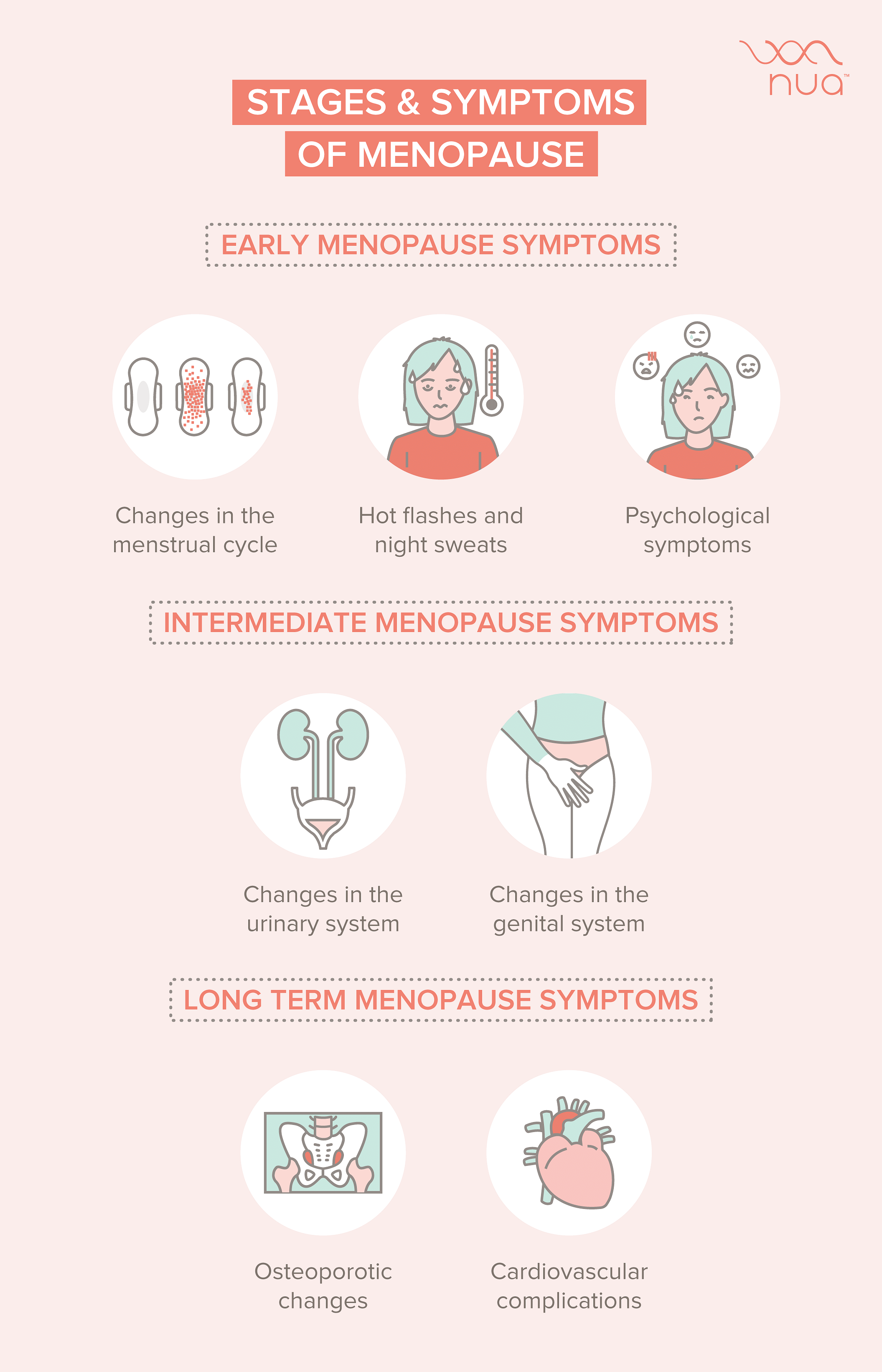Although every woman is bound to experience menopause, the duration and severity of an individual’s symptoms are dependent on her psychosocial, cultural, and environmental factors.
A woman may experience symptoms of menopause either 10 years before or 12 years after it occurs. While a shorter menopause period is frequently considered to exhibit more severe symptoms, a woman’s mindset towards it also has a great impact on how it affects her body.
In this article, we will discuss the symptoms of menopause at its various stages.
Early Menopause Symptoms
- Changes in the menstrual cycle:
Menopause leads to a fall in oestrogen and progesterone levels in a woman’s body, causing the ovaries to stop functioning. At the onset of menopause, a woman is likely to experience irregularities in her monthly menstrual cycle. These irregularities could affect the duration and heaviness of her monthly period, it may also cause occasional spotting. When a woman has missed 12 consecutive period cycles, she has reached menopause.
- Hot flashes and night sweats:
The most frequently occurring and widely experienced menopause symptom is hot flashes, which are sudden feelings of heat in the body. Hot flashes are typically followed up by hot flushes, which is when the face and neck turn red making the woman feel sweaty and flushed. The duration varies, ranging from 30 seconds up to 10 minutes, and so does the intensity, which can be severe enough to wake women up at night due to night sweats. Hot flashes last for an average of 1 – 2 years after a woman’s final period and decrease with intensity over time.
- Psychological symptoms:
This includes mood changes, insomnia, difficulty in concentration, loss of self-esteem, depression, and most importantly, loss of self-confidence. It is difficult to pinpoint all the reasons but a drop in oestrogen is seen to be most evident. Two of the most important risk factors for difficult menopausal mood swings are a history of severe premenstrual syndrome (PMS) and prior episodes of depression or other significant mental health issues. Women may also have a greater risk of emotional problems during menopause, especially if they have a difficult living situation.
Intermediate Menopause Symptoms
- Vaginal Dryness:
The decreased production of oestrogen and progesterone during menopause causes thinning of the vaginal wall, thereby decreasing natural lubrication. Women can experience vaginal dryness because of this. It is also common to feel less interested in sex during menopause. Lower levels of oestrogen in the body can also cause physical changes in the genitals. The vagina tends to become shorter and narrower with thinning of its lining. Women who remain sexually active face a lower range of these problems as constant blood flow is maintained with the activity to their vagina, thereby leading to maintained lubrication.
- Recurrent urinary infections:
Like the vaginal wall, the urethra (the tube that drains the bladder and is used for urination) undergoes changes due to a drop in oestrogen. These changes in the urethra may lead to different kinds of urinary symptoms, including increased susceptibility to urinary tract infections. Some of the urinary symptoms that can be associated with menopause are the urge to urinate often, discomfort or burning with urination, leakage of urine with coughing, laughing, or even lifting heavy objects.
Long term Menopause Symptoms
- Osteoporosis:
Osteoporosis, meaning porous bone, is a condition where there is reduced bone mass. This leads to diminished strength of the skeleton and increased susceptibility to fractures. After menopause, bone resorption (or breakdown) overtakes the building of new bone. Early menopause (before the of age 45 years) combined with low hormone levels and infrequent periods can cause loss of bone mass. It is often called a ‘silent disease’ as a woman may not know she has osteoporosis until her bones become so weak that a sudden strain, bump, or fall causes a fracture or a vertebra to collapse. A collapsed vertebra after menopause may first be noticed when a woman suffers back pain, loss of height, or other spinal issues. Other clinical signs of osteoporosis are joint pains and leg cramps.
- Cardiovascular complications:
Women are protected from heart attacks and strokes during reproductive years due to oestrogen. Oestrogen is believed to have a positive effect on the inner layer of the artery wall, helping to keep blood vessels flexible. That means they can relax and expand to accommodate blood flow. So a decline in oestrogen increases the risk of heart attack and stroke both. One must be cautious to get regular checkups to ensure their cardiovascular function is not compromised.

Every woman’s menopause experience is unique. Although it seems daunting, with the right assistance from your doctor, all the signs and symptoms can be managed well. It’s a new journey that should be embraced. Know that you are not alone and will receive the support you need along the way.
Our experts work round the clock to provide you with the answers that you are looking for. If you have any, leave it in the comment section below or send us a DM at @nuawoman. This is a safe space so don’t hold back on any doubts you may have about your body and mind. Read our other Community Asks here.
Read all of Dr. Ahuja’s other articles here.










This website really has all the information and facts I needed concerning this subject and I didn’t know who to ask.